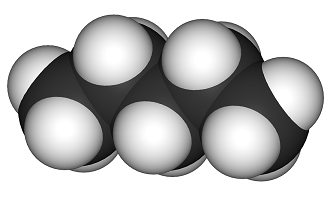Pentane
Pentane is an alkane with the formula C5H12. As a hydrocarbon, it can undergo hydrocarbon combustion which gives off heat. Traces of pentane can be found in raw natural gas, which is a type of fossil fuel.[2] This pentane is usually removed before being shipped to customers as an energy currency.
Pentane is a volatile, colourless liquid with a characteristic gasoline-like odour.[3] In addition to being a component of natural gas, pentane has numerous industrial uses. Primarily, pentane is used to create a blowing agent which is then used to create a foam known as polystyrene. Polystyrene is used to make insulation materials for refrigerators and heating pipes.[4] As well, pentane is used in geothermal power stations as a binary fluid, due to its low boiling point (36oC[5]).[6]
Properties
Below is a table of some of the basic properties of pentane.
| Formula | C5H12 |
| Molar mass | 72.15 grams/mole |
| Melting Point | -130oC[5] |
| Boiling Point | 36oC[5] |
Combustion Reaction
As is the case with other hydrocarbons, pentane undergoes hydrocarbon combustion, combining with oxygen to form carbon dioxide. The balanced chemical equation for the complete combustion of pentane is:
The hydrocarbon combustion reaction releases heat energy and is an example of an exothermic reaction. The reaction also has a negative enthalpy change (ΔH) value.
For Further Reading
- Chemical energy
- Chemical bond
- Combustion
- Primary energy
- Energy conversion technology
- Or explore a random page
References
- ↑ "Pentane-3D-space-filling". Licensed under Public Domain via Wikimedia Commons - http://commons.wikimedia.org/wiki/File:Pentane-3D-space-filling.png#mediaviewer/File:Pentane-3D-space-filling.png
- ↑ “NATURAL GAS FAQs,” Pacific Northern Gas RSS. [Online]. Available: http://www.png.ca/natural-gas-faqs/. [Accessed: 24-May-2017]
- ↑ National Center for Biotechnology Information. (2015). Properties of Pentane [Online]. Available: http://pubchem.ncbi.nlm.nih.gov/compound/pentane#section=Experimental-Properties [February 16, 2015].
- ↑ Cornell Biochem. (2015). Pentane [Online]. Available: https://cornellbiochem.wikispaces.com/Pentane#Uses [February 16, 2015].
- ↑ 5.0 5.1 5.2 Charles E. Ophardt. (2003). Virtual Chembook - Hydrocarbon Boiling Points [Online]. Available: http://www.elmhurst.edu/~chm/vchembook/501hcboilingpts.html [February 16,2015].
- ↑ Willie Scott. (November 15, 2010). Geothermal Power Plants [Online]. Available: http://www.brighthub.com/environment/renewable-energy/articles/53953.aspx [February 16, 2015].


